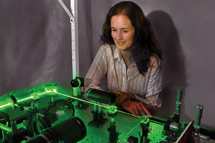
A new class of very small handheld devices uses light-wave interference to detect motion a thousand times more subtly than any tool known.
“There was nothing in the [optics] literature to predict that this would happen,” says Sandia researcher Dustin Carr (1769).
The patent-applied-for device will be the subject of an invited talk at the SPIE Optics East convention in Philadelphia in October, delivered by team member Bianca Keeler (1769).
Similar in operation to the shadow pictures projected onto a wall by shining light through the fingers of one hand moving over the fingers of the other, the relatively simple measuring device depends upon a formerly unrecognized property of optics: light diffracted from very small gratings that move very small lateral distances undergoes a relatively big, and thus easily measurable, change in reflection. A motion of 10 nanometers (nm) can be seen by the naked eye, says Dustin.
“The device couldn’t exist unless you made it this small,” he says. Features are in the 100-200 nm range, with 300 nm between top and bottom combs and 600 to 900 nm between comb teeth. “In MEMS [microelectromechanical] applications, very few things that sell are dominated by miniaturization. There’s not a motivation in MEMS to make things still smaller as a matter of cost; the economics of scale for integrated circuits just don’t apply to MEMS.”
But here, size matters, and small is crucial: sub-wavelength interference effects cause the visual display.
“Making use of the effect is fairly obvious once you realize it happens,” he says.
Fabricated out of polysilicon by standard lithography techniques similar to that used to make MEMS devices, the Sandia system uses two tiny comb-like structures (instead of fingers) laid one over each other. The bottom comb is locked rigidly in place. The top comb is secured only by horizontal springs. Any tiny motion sends the top comb skittering over the bottom comb, laterally deforming the grating. A very tiny disturbance changes by an unexpectedly large amount the amplitude of light — in the visible to near-infrared range — diffracted from a tiny laser beam shining upon the apparatus.
The measuring device, still in the laboratory stage, is in effect a kind of accelerometer, about the size of the inexpensive microelectromechanical devices that open air bags, and has multiple possible uses.
“If you can make very sensitive detectors very cheaply and very small, there are huge applications,” says Dustin. “Made small, synchronized, cheap, and placed on every block, we could take data from all these sensors at once and measure the motion of the earth when there’s not an earthquake. So we could learn what leads up to one.” Another use would be for skid and traction control in cars, detecting if the back end of the car is moving in a different direction from the front end.
“Such devices also could take the place of inertial navigation systems,” Dustin says. These typically require large gyroscopes to keep commercial airplanes moving on a preset course. “We could have handheld-sized devices on Volkswagens that would work even in a tunnel.”
Other defense applications are possible, he says.
He sees a time frame of three to five years before the devices are available for use.
Also involved in the project are Greg Bogart (1749), John Sullivan, Tom Friedmann (both 1112), and Joel Wendt (1743)